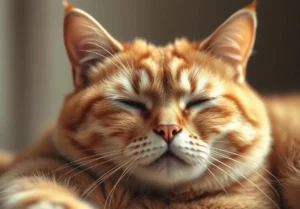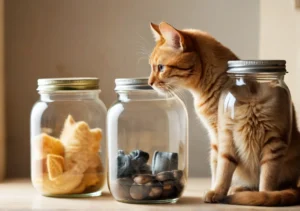Cats are curious creatures that often exhibit quirky behaviors that leave us scratching our heads. One common behavior that many cat owners may have observed is their feline friend scratching at glass surfaces. But why do cats engage in this peculiar activity? Let’s explore the reasons behind this behavior in our blog post.
Have you ever wondered why cats scratch glass? In this blog post, we will delve into the reasons why cats exhibit this behavior and how you can help prevent it in your home.
Natural Instincts
Cats scratching at glass is often driven by their natural instincts. In the wild, cats use their claws to mark their territory and sharpen their claws. When they scratch at glass surfaces, they may be trying to establish their territory or simply satisfying their instinct to scratch.
An additional unique insight is that cats’ claws also contain scent glands, so when they scratch at glass, they leave behind pheromones that can communicate messages to other cats. This behavior is a way for cats to mark their territory and communicate with other felines in the area.
Visual Stimulation
Cats may also scratch at glass surfaces as a form of visual stimulation. The reflective nature of glass can create interesting visual effects when a cat scratches at it, providing them with entertainment and mental stimulation. Additionally, the sound of their claws against the glass may be satisfying to them in a sensory way.
If you’re concerned about your cat scratching at glass, consider providing them with alternative scratching posts or surfaces to redirect this behavior. This will not only protect your glass surfaces but also fulfill their natural instinct to scratch in a more appropriate way.
Territory Marking
Cats scratch glass as a way to mark their territory. Cats have scent glands on their paws, so when they scratch surfaces like glass, they leave behind their scent. This behavior helps them communicate with other cats in the area and establish boundaries. If you notice your cat scratching on glass doors or windows, it’s likely their way of saying, “This is mine!”
Claws Maintenance
When cats scratch on glass, they are also maintaining their claws. Scratching helps remove the dead outer layer of their claws and keeps them sharp and healthy. It’s a natural instinct for cats to scratch to keep their claws in good shape for hunting and self-defense. Providing scratching posts or mats can help redirect this behavior and protect your glass surfaces from scratches.
Additional Unique Insight:
In addition to maintaining claws , scratching on glass can also help cats stretch their muscles. The act of stretching while scratching can provide a good full-body stretch for cats, keeping them limber and healthy. So, if you see your cat scratching on glass, they might be multitasking by both marking territory and getting in a good stretch.
Boredom and Stress
Cats scratching at glass can be a sign of boredom or stress. Just like us humans, our feline friends need mental stimulation and a stress-free environment to thrive. If your cat is feeling cooped up or anxious, they may resort to scratching at glass as a way to release pent-up energy or frustration. Consider enriching their environment with interactive toys, scratching posts, or even a window perch to gaze outside and watch the world go by. Taking the time to play with your cat and provide opportunities for them to engage in natural behaviors can help alleviate boredom and reduce stress levels, ultimately curbing their glass-scratching tendencies.
Redirecting the Behavior
If your cat has developed a habit of scratching at glass, it’s essential to provide alternative outlets for their scratching needs. Invest in a sturdy scratching post or pad made of materials like sisal or cardboard, as these textures mimic the feeling of scratching on tree bark or rough surfaces. Place the scratching post near the area where your cat usually scratches at glass to encourage them to redirect their behavior. You can also try using double-sided tape or a citrus-based deterrent on the glass surfaces to discourage scratching. Remember to reward your cat with treats and praise when they use the scratching post instead of the glass, reinforcing positive behavior. With patience and consistency, you can help your cat break the glass-scratching habit and protect your windows from damage.
Unique Insight: Environmental Enrichment
In addition to providing alternative scratching surfaces, consider enriching your cat’s environment to prevent boredom and reduce stress. Offer a variety of toys, climbing structures, hiding spots, and puzzle feeders to keep your cat mentally stimulated and physically active. Rotating toys regularly and creating a routine of playtime and interaction can help prevent boredom-related behaviors like glass scratching. By creating a stimulating and engaging environment for your cat, you can help address the root causes of their unwanted behavior and promote overall well-being.
Environmental Enrichment
Cats often scratch glass surfaces out of boredom or a lack of mental stimulation. To prevent this behavior, consider enriching your cat’s environment with interactive toys, scratching posts, window perches, and puzzle feeders. These items can help keep your cat mentally engaged and physically active, reducing the likelihood of them resorting to scratching on glass. Additionally, providing appropriate scratching posts made of materials like sisal or cardboard can redirect your cat’s scratching instincts to more suitable surfaces.
To further prevent glass scratching, consider placing double-sided sticky tape or aluminum foil on the areas your cat tends to scratch. Cats generally dislike the sticky or crinkly texture of these materials and may avoid scratching the glass altogether. Remember to praise and reward your cat when they use their scratching posts instead of the glass, reinforcing positive behaviors.
Fun Facts About Cats and Their Scratchy Behaviors
- Cats Mark Their Territory: Scratching is a natural behavior for cats because it helps them mark their territory. When cats scratch, they release scent markers from glands on their paws, leaving a familiar scent behind.
- Visual Communication: Cats also scratch surfaces, including glass, to visually communicate with other cats. By leaving visible scratch marks, cats can assert dominance or attract potential mates.
- Maintaining Claws: Scratching helps cats shed the outer layers of their claws to keep them healthy and sharp. By scratching on different surfaces, cats can maintain their claws at an optimal length.
For more information on creating a cat-friendly environment and preventing unwanted scratching behaviors, you can visit the American Association of Feline Practitioners website: American Association of Feline Practitioners.
Alex, a passionate animal lover, has experience in training and understanding animal behavior. As a proud pet parent to two dogs and three cats, he founded AnimalReport.net to share insights from animal experts and expand his knowledge of the animal kingdom.




